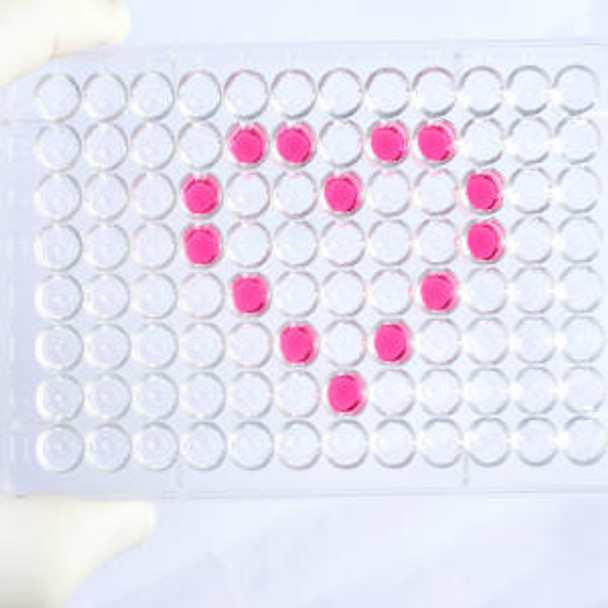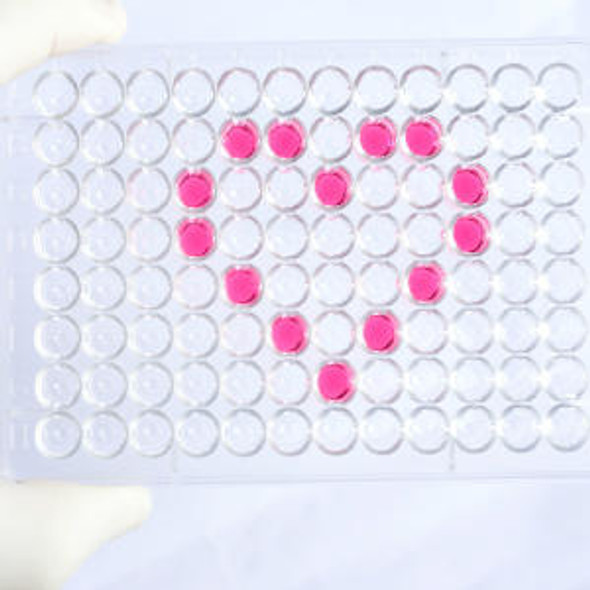Human Immunology ELISA Kits 8
Human Polycystin-2 (PKD2) ELISA Kit
- SKU:
- HUEB1637
- Product Type:
- ELISA Kit
- Size:
- 96 Assays
- Uniprot:
- Q13563
- Range:
- 0.312-20 ng/mL
- ELISA Type:
- Sandwich
- Synonyms:
- PKD2, Polycystin-2, Polycystwin, Autosomal dominant polycystic kidney disease type II protein, Polycystic kidney disease 2 protein
- Reactivity:
- Human
Description
| Product Name: | Human Polycystin-2 (PKD2) ELISA Kit |
| Product Code: | HUEB1637 |
| Alias: | Polycystin-2, Autosomal dominant polycystic kidney disease type II protein, Polycystic kidney disease 2 protein, Polycystwin, R48321, PKD2 |
| Uniprot: | Q13563 |
| Reactivity: | Human |
| Range: | 0.312-20 ng/mL |
| Detection Method: | Sandwich |
| Size: | 96 Assay |
| Storage: | Please see kit components below for exact storage details |
| Note: | For research use only |
| UniProt Protein Function: | PKD2: Involved in fluid-flow mechanosensation by the primary cilium in renal epithelium. PKD1 and PKD2 may function through a common signaling pathway that is necessary for normal tubulogenesis. Acts as a regulator of cilium length, together with PKD1. The dynamic control of cilium length is essential in the regulation of mechanotransductive signaling. The cilium length response creates a negative feedback loop whereby fluid shear-mediated deflection of the primary cilium, which decreases intracellular cAMP, leads to cilium shortening and thus decreases flow-induced signaling. Functions as a calcium permeable cation channel. Defects in PKD2 are the cause of polycystic kidney disease autosomal dominant type 2 (ADPKD2). ADPKD2 is a disorder characterized by progressive formation and enlargement of cysts in both kidneys, typically leading to end-stage renal disease in adult life. Cysts also occurs in the liver and other organs. It represents approximately 15% of the cases of autosomal dominant polycystic kidney disease. ADPKD2 is clinically milder than ADPKD1 but it has a deleterious impact on overall life expectancy. Belongs to the polycystin family. 5 isoforms of the human protein are produced by alternative splicing. |
| UniProt Protein Details: | Protein type:Membrane protein, integral; Channel, cation; Membrane protein, multi-pass Chromosomal Location of Human Ortholog: 4q22.1 Cellular Component: filamentous actin; endoplasmic reticulum membrane; nonmotile primary cilium; endoplasmic reticulum; integral to plasma membrane; lamellipodium; cytoplasm; basal plasma membrane; plasma membrane; motile primary cilium; intercellular junction; basal cortex; cilium Molecular Function:voltage-gated cation channel activity; actinin binding; identical protein binding; protein homodimerization activity; phosphoprotein binding; voltage-gated ion channel activity; calcium ion binding; muscle alpha-actinin binding; ATPase binding; calcium-induced calcium release activity; voltage-gated calcium channel activity; protein binding; potassium channel activity; voltage-gated sodium channel activity; cytoskeletal protein binding; HLH domain binding; receptor binding Biological Process: neural tube development; positive regulation of inositol-1,4,5-triphosphate receptor activity; embryonic placenta development; cytoplasmic sequestering of transcription factor; positive regulation of nitric oxide biosynthetic process; regulation of cAMP metabolic process; heart development; detection of mechanical stimulus; JAK-STAT cascade; liver development; G1/S-specific positive regulation of cyclin-dependent protein kinase activity; regulation of cell proliferation; negative regulation of cell proliferation; ureteric bud branching; spinal cord development; release of sequestered calcium ion into cytosol; calcium ion transport; positive regulation of transcription from RNA polymerase II promoter; heart looping; cell cycle arrest; determination of left/right symmetry; centrosome duplication Disease: Polycystic Kidney Disease 2 |
| NCBI Summary: | This gene encodes a member of the polycystin protein family. The encoded protein is a multi-pass membrane protein that functions as a calcium permeable cation channel, and is involved in calcium transport and calcium signaling in renal epithelial cells. This protein interacts with polycystin 1, and they may be partners in a common signaling cascade involved in tubular morphogenesis. Mutations in this gene are associated with autosomal dominant polycystic kidney disease type 2. [provided by RefSeq, Mar 2011] |
| UniProt Code: | Q13563 |
| NCBI GenInfo Identifier: | 116242717 |
| NCBI Gene ID: | 5311 |
| NCBI Accession: | Q13563.3 |
| UniProt Secondary Accession: | Q13563,O60441, Q15764, Q2M1Q3, Q2M1Q5, |
| UniProt Related Accession: | Q13563 |
| Molecular Weight: | 968 |
| NCBI Full Name: | Polycystin-2 |
| NCBI Synonym Full Names: | polycystic kidney disease 2 (autosomal dominant) |
| NCBI Official Symbol: | PKD2 |
| NCBI Official Synonym Symbols: | PC2; PKD4; Pc-2; APKD2; TRPP2 |
| NCBI Protein Information: | polycystin-2; R48321; polycystwin; autosomal dominant polycystic kidney disease type II protein; transient receptor potential cation channel, subfamily P, member 2 |
| UniProt Protein Name: | Polycystin-2 |
| UniProt Synonym Protein Names: | Autosomal dominant polycystic kidney disease type II protein; Polycystic kidney disease 2 protein; Polycystwin; R48321 |
| Protein Family: | Polycystin |
| UniProt Gene Name: | PKD2 |
| UniProt Entry Name: | PKD2_HUMAN |
| Component | Quantity (96 Assays) | Storage |
| ELISA Microplate (Dismountable) | 8×12 strips | -20°C |
| Lyophilized Standard | 2 | -20°C |
| Sample Diluent | 20ml | -20°C |
| Assay Diluent A | 10mL | -20°C |
| Assay Diluent B | 10mL | -20°C |
| Detection Reagent A | 120µL | -20°C |
| Detection Reagent B | 120µL | -20°C |
| Wash Buffer | 30mL | 4°C |
| Substrate | 10mL | 4°C |
| Stop Solution | 10mL | 4°C |
| Plate Sealer | 5 | - |
Other materials and equipment required:
- Microplate reader with 450 nm wavelength filter
- Multichannel Pipette, Pipette, microcentrifuge tubes and disposable pipette tips
- Incubator
- Deionized or distilled water
- Absorbent paper
- Buffer resevoir
*Note: The below protocol is a sample protocol. Protocols are specific to each batch/lot. For the correct instructions please follow the protocol included in your kit.
Allow all reagents to reach room temperature (Please do not dissolve the reagents at 37°C directly). All the reagents should be mixed thoroughly by gently swirling before pipetting. Avoid foaming. Keep appropriate numbers of strips for 1 experiment and remove extra strips from microtiter plate. Removed strips should be resealed and stored at -20°C until the kits expiry date. Prepare all reagents, working standards and samples as directed in the previous sections. Please predict the concentration before assaying. If values for these are not within the range of the standard curve, users must determine the optimal sample dilutions for their experiments. We recommend running all samples in duplicate.
| Step | |
| 1. | Add Sample: Add 100µL of Standard, Blank, or Sample per well. The blank well is added with Sample diluent. Solutions are added to the bottom of micro ELISA plate well, avoid inside wall touching and foaming as possible. Mix it gently. Cover the plate with sealer we provided. Incubate for 120 minutes at 37°C. |
| 2. | Remove the liquid from each well, don't wash. Add 100µL of Detection Reagent A working solution to each well. Cover with the Plate sealer. Gently tap the plate to ensure thorough mixing. Incubate for 1 hour at 37°C. Note: if Detection Reagent A appears cloudy warm to room temperature until solution is uniform. |
| 3. | Aspirate each well and wash, repeating the process three times. Wash by filling each well with Wash Buffer (approximately 400µL) (a squirt bottle, multi-channel pipette,manifold dispenser or automated washer are needed). Complete removal of liquid at each step is essential. After the last wash, completely remove remaining Wash Buffer by aspirating or decanting. Invert the plate and pat it against thick clean absorbent paper. |
| 4. | Add 100µL of Detection Reagent B working solution to each well. Cover with the Plate sealer. Incubate for 60 minutes at 37°C. |
| 5. | Repeat the wash process for five times as conducted in step 3. |
| 6. | Add 90µL of Substrate Solution to each well. Cover with a new Plate sealer and incubate for 10-20 minutes at 37°C. Protect the plate from light. The reaction time can be shortened or extended according to the actual color change, but this should not exceed more than 30 minutes. When apparent gradient appears in standard wells, user should terminatethe reaction. |
| 7. | Add 50µL of Stop Solution to each well. If color change does not appear uniform, gently tap the plate to ensure thorough mixing. |
| 8. | Determine the optical density (OD value) of each well at once, using a micro-plate reader set to 450 nm. User should open the micro-plate reader in advance, preheat the instrument, and set the testing parameters. |
| 9. | After experiment, store all reagents according to the specified storage temperature respectively until their expiry. |
When carrying out an ELISA assay it is important to prepare your samples in order to achieve the best possible results. Below we have a list of procedures for the preparation of samples for different sample types.
| Sample Type | Protocol |
| Serum | If using serum separator tubes, allow samples to clot for 30 minutes at room temperature. Centrifuge for 10 minutes at 1,000x g. Collect the serum fraction and assay promptly or aliquot and store the samples at -80°C. Avoid multiple freeze-thaw cycles. If serum separator tubes are not being used, allow samples to clot overnight at 2-8°C. Centrifuge for 10 minutes at 1,000x g. Remove serum and assay promptly or aliquot and store the samples at -80°C. Avoid multiple freeze-thaw cycles. |
| Plasma | Collect plasma using EDTA or heparin as an anticoagulant. Centrifuge samples at 4°C for 15 mins at 1000 × g within 30 mins of collection. Collect the plasma fraction and assay promptly or aliquot and store the samples at -80°C. Avoid multiple freeze-thaw cycles. Note: Over haemolysed samples are not suitable for use with this kit. |
| Urine & Cerebrospinal Fluid | Collect the urine (mid-stream) in a sterile container, centrifuge for 20 mins at 2000-3000 rpm. Remove supernatant and assay immediately. If any precipitation is detected, repeat the centrifugation step. A similar protocol can be used for cerebrospinal fluid. |
| Cell culture supernatant | Collect the cell culture media by pipette, followed by centrifugation at 4°C for 20 mins at 1500 rpm. Collect the clear supernatant and assay immediately. |
| Cell lysates | Solubilize cells in lysis buffer and allow to sit on ice for 30 minutes. Centrifuge tubes at 14,000 x g for 5 minutes to remove insoluble material. Aliquot the supernatant into a new tube and discard the remaining whole cell extract. Quantify total protein concentration using a total protein assay. Assay immediately or aliquot and store at ≤ -20 °C. |
| Tissue homogenates | The preparation of tissue homogenates will vary depending upon tissue type. Rinse tissue with 1X PBS to remove excess blood & homogenize in 20ml of 1X PBS (including protease inhibitors) and store overnight at ≤ -20°C. Two freeze-thaw cycles are required to break the cell membranes. To further disrupt the cell membranes you can sonicate the samples. Centrifuge homogenates for 5 mins at 5000xg. Remove the supernatant and assay immediately or aliquot and store at -20°C or -80°C. |
| Tissue lysates | Rinse tissue with PBS, cut into 1-2 mm pieces, and homogenize with a tissue homogenizer in PBS. Add an equal volume of RIPA buffer containing protease inhibitors and lyse tissues at room temperature for 30 minutes with gentle agitation. Centrifuge to remove debris. Quantify total protein concentration using a total protein assay. Assay immediately or aliquot and store at ≤ -20 °C. |
| Breast Milk | Collect milk samples and centrifuge at 10,000 x g for 60 min at 4°C. Aliquot the supernatant and assay. For long term use, store samples at -80°C. Minimize freeze/thaw cycles. |






